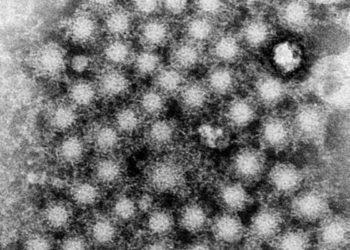Novel pill-only regimens effective against hepatitis C [COSMOS and HALLMARK-DUAL study]
1. [COSMOS study]: Simeprevir plus sofosbuvir achieved high sustained virological response 12 weeks after stopping treatment (SVR12) in patients with chronic HCV genotype 1 infections.
2. [HALLMARK-DUAL study]: Daclatasvir plus asunaprevir achieved high SVR12 in patients with chronic HCV genotype 1b infections.
Evidence Rating Level: 1 (Excellent)
Study Rundown: Hepatitis C infection is associated with significant mortality and morbidity – of the approximately 5,000 liver transplants performed in the US each year, at least 40% are attributable to chronic hepatitis C infections. Results of two randomized-controlled trials involving novel pill-only regimens were reported in Lancet on the World Hepatitis Day: in the COSMOS study, simeprevir plus sofosbuvir was shown to be highly effective against chronic HCV genotype 1 infections, with SVR12 over 90%. The regimen was well tolerated with serious adverse events rate of 2%. In the HALLMARK-DUAL study, daclatasvir plus asunaprevir was shown to be effective against chronic HCV genotype 1b infections, with SVR12 of 90% in treatment-naive patients. The regimen was well tolerated with serious adverse events rate of 6%. Both trials were well-designed with patient randomization. The small number of participants in the COSMOS study (168 patients) may moderately limit power.
The COSMOS study was funded by Janssen.
The HALLMARK-DUAL study was funded by Bristol-Myers Squibb.
Click to read the COSMOS study, published today in The Lancet
Click to read the HALLMARK-DUAL study, published today in The Lancet
Relevant Reading: Sofosbuvir for previously untreated chronic hepatitis C infection
In-Depth [randomized controlled trials]: The COSMOS study was a randomized controlled trial involving 167 patients. Patients were divided into 2 cohorts: previous non-responders with METAVIR scores F0-F2 (cohort 1) and previous non-responders and treatment-naive patients with METAVIR scores F3-F4 (cohort 2). Patients were randomized to 4 groups in a 2:2:1:1 ratio: simeprevir and sofosbuvir with (group 1) or without (group 2) ribavirin for 24 weeks, or simeprevir and sofosbuvir with (group 3) or without (group 4) ribavirin for 12 weeks. The primary endpoint was sustained virological response 12 weeks after treatment (SVR12). SVR12 rate was 90% (95% confidence interval [CI], 81-96) for cohort 1 and 94% (95% CI, 87-98) for cohort 2. Subgroup analyses did not demonstrate an SVR12 advantage for the longer treatment duration – SVR12 was 94% after 12 weeks of treatment and 91% after 24 weeks of treatment. There was no on-treatment virological failure. In safety analyses, the rate of discontinuation due to adverse events was 2% (4 patients). The most common adverse events were fatigue (31%), headache (20%) and nausea (16%).
The HALLMARK-DUAL study was a phase 3 randomized controlled trial. Treatment-naive patients (n=307) were randomized in a 2:1 ratio to receive daclatasvir plus asunaprevir or placebo for 12 weeks. There were an additional 205 non-responders and 235 ineligible/intolerant patients. Non-responders and ineligible/intolerant patients were given open-label daclatasvir plus asunaprevir for 24 weeks as they generally had more advanced disease. The primary endpoints were SVR12 rates for the treatment-naive patients and non-responders. SVR12 rates were 90% (95% CI, 85-94) in the treatment-naive cohort, 82% (95% CI, 77-87) in the non-responder cohort, and 82% (95% CI, 77-87) in the ineligible/intolerant cohort. The SVR12 rates were similar for patients with (84%) or without (85%) cirrhosis. HCV RNA reductions from baseline were rapid and sustained with 4.8-5.0 log10 IU/mL reduction at week 2 before becoming undetectable at week 4 in 83% of treatment-naive patients. In safety analyses, the most common adverse events were headache, fatigue, diarrhea, nausea, and asthenia. Rate of serious adverse events on treatment was 6% (39 patients). Rates of overall adverse events were similar in treatment-naive patients receiving daclatasvir plus asunaprevir or placebo.
More from this author: New dengue fever vaccine effective in phase 3 trial, Insulin pumps more effective than multiple daily injections in type II diabetics [OpT2mise trial], Heart attack hospitalization rate in China quadruples from 2001-2011, Vitamin D supplementation does not reduce risk of falls, ¹⁸F-FDG PET brain imaging could predict recovery in vegetative patients
Image: CC/Wiki
©2012-2014 2minutemedicine.com. All rights reserved. No works may be reproduced without expressed written consent from 2minutemedicine.com. Disclaimer: We present factual information directly from peer reviewed medical journals. No post should be construed as medical advice and is not intended as such by the authors, editors, staff or by 2minutemedicine.com. PLEASE SEE A HEALTHCARE PROVIDER IN YOUR AREA IF YOU SEEK MEDICAL ADVICE OF ANY SORT.






